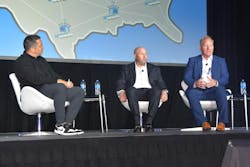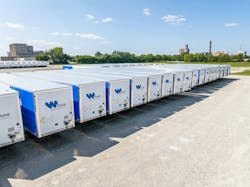LOUISVILLE, Kentucky—The promise of the Trailers as a Service model is compelling, at least as Cory O’Brien, Wabash VP of digital enablement, explains it.
“The new model is founded on a national network of both capacity and maintenance, allowing a new level of flexibility and efficiency to our customers,” O’Brien said, kicking off a discussion at Wabash Ignite, a gathering of select Wabash customers, dealers, and suppliers here.
Loadsmith CEO Brett Suma founded the Denver-based, third-party Capacity-as-a-Service logistics company in 2019, with the goal of becoming the “first fully autonomous trucking company” in North America. But, coming from a large, asset-based fleet, he knew he didn’t want to sink a lot of early capital into equipment he wouldn’t need for some time.
“Trucking companies that are growth-minded are going to think about growth in a way of the freight coming first and then investing in trailers, in a ratio that allows them to grow from a trailer-to-tractor perspective,” Suma said. “But, ultimately, trailer utilization is a very, very difficult thing to get right when you're dealing with customers and the volatility in the freight market.”
However, if a carrier decides to be fiscally conservative and not invest in surplus trailer capacity, it’s going to have a hard time growing—since shippers are looking for greater and greater trailer capacity in their RFPs, and the freight goes to fleets with an abundance of equipment.
But while finding a third party to supplement trailer capacity was once routine, shippers are now asking for branded trailers.
“You have to have a universal pool that can go to multiple locations, and not just a carrier that can only haul one lane,” Suma said.
Of course, all that equipment also requires service infrastructure—at an additional and significant cost for an asset-based carrier.
“When I look at the Wabash TaaS network, as somebody who doesn't want to have an infrastructure, I see an opportunity to partner with a company that has that infrastructure,” Suma said. “I don't have to build a shop and hire mechanics and buy tool sets and manage that shop.”
The bottom line: “How do you act, feel, and deliver bigger than you are? It's through a partnership with somebody who is bigger than you are,” he added. “And, from a trailer perspective, why wouldn't you want to be partnered with a manufacturer? To me, it makes a lot of sense. I can participate in that RFP knowing that I have the backing of the TaaS platform to inform my decision, in terms of what freight to go after.”
Dealer technology
But while a shop with skilled technicians is necessary, it’s no longer sufficient for maintaining a modern, connected supply chain. To keep up, dealers and service centers are investing in technology.
“It's a need of our customers, managing their uptime,” said Travis “TJ” Johnson, president of Intermountain Trailer, one of the largest semi-trailer dealerships in the West. “The more information we can collect sooner, the better it is for us. We invested in some specific units that helped us do PMs, for example. We can provide real-time diagnostics, we can provide photos of failures, and it completely revolutionized the way that we were able to go back to and see approvals and have them done quickly.”
Likewise, mobile service units can perform the same tasks and provide the same reporting as the shop by going to where the TaaS trailers are located.
“We're learning to be more efficient,” Johnson said. “We're learning to use technology differently than we did before, and we're continuing to lean into that.”
And another advantage of the Wabash offering is that the TaaS units come with advanced telematics, maintenance costs, and insurance included.
“With the TaaS network, we're able to have brand new equipment and the service intervals that TJ and his wonderful team do,” Suma said. “And then we also benefit from a repair perspective, from a damage attribution component, all the way through to the actual repair and then the redeployment of that trailer.”
What about trailer sales?
Stocking TaaS units does entail a shift in thinking at a dealership, Johnson noted.
“Obviously, we enjoy representing this great brand of Wabash and selling that equipment—and we're a for-profit dealership, don't get me wrong,” he said. “So when we think about how this encroaches into our sales business, we’ve come to understand that it's a segment—and it’s definitely a segment of business that we were not addressing.”
And it’s a different segment than a traditional trailer rental business, he noted. So customers need a certain amount of education as well.
“As the TaaS product starts to take on a life of its own, we're leaning into what that looks like for our customers, and we're having conversations,” Johnson said. “Two years ago, I would’ve said that a company like Loadsmith actually competing for an RFP was pie in the sky—this isn’t real. But I’ve heard from a customer who said, ‘No, this is real, and it's impacting the way that we go to business on the asset side.’ So it's here—we're seeing it firsthand, and it's a delicate line that we walk, for sure. We’re not going to turn any business away—it's just a different type of customer base.”
And even a customer like Loadsmith, it turns out, has evolving needs, as Suma explained.
“We're going to scale with the TaaS flex option,” he said, referring to the Wabash option for flexible commitment terms. “Ultimately, those flex trailers that we scale with turn into full five-year TaaS schedules. Then, beyond that, I can see us having a fleet that we purchase, a fleet that is the traditional five-year TaaS model, and then continuing to leverage that flex model.
“When I look at the future, especially with the way that shippers work and the requirements they have, there's going to be more and more trailers in the system.”
The impact of autonomy
A well-run dry-van carrier will have a ratio of 2.5:1 or 3:1 trailers to power units, Suma noted, while dedicated fleets will have a ratio of 5:1.
“In the autonomous world, it is a seven-to-one ratio—that is a huge multiplication from the current construct,” he said. “If I'm a trailer dealer, there are going to be a lot of purchases in the next 10 years. I don't think that TaaS going to prohibit purchases. The overall market is going to grow significantly because of ancillary technologies that are coming in and changing the overall way that goods are moved in the United States.”
Not only will autonomous trucking require more trailers, but the operational shift, ironically, could require more drivers as well, or so Suma envisions. (Suma goes into detail about the Loadsmith model, and a deal for 800 autonomous trucks with Kodiak Robotics, here in a previous FleetOwner interview.)
Learning by doing
For Wabash, TaaS came about as part of the push to develop new kinds of solutions, but the program has generated unplanned internal benefits as well, O’Brien explained to FleetOwner in a follow-up discussion.
“We're trying to understand our customer and our customer's customer better to figure out what problems, big problems, that Wabash can solve,” he said. “With TaaS, we can run a fleet in order to understand the problems that fleets go through. And now we are making the best trailer it can be because we have this real-time feedback loop right into our engineering team.
“We see the things that are failing, and we fix them. We've gotten feedback in the past from customers, but there's nothing like running it yourself to really get it.”
Similarly, the TaaS offering is the result of taking a chance when it would’ve been easier, and possibly more sensible, not to try something new. For anyone checking the calendar, TaaS launched a couple of years ago during the height of the supply crunch, when OEMs simply couldn’t meet the demand for new trailers.
So reserving prized units for an experiment took a certain amount of nerve.
‘[CEO] Brent [Yeagy] was saying the same thing about not being afraid to fail then as he has here [at Wabash Ignite]: We are going to innovate; we are going to do things different,” O’Brien said. “We're going to invest now when it's good, and we're going to be investing on the other side. We set aside an allocation of trailers for this program because we needed to continue to innovate and build new solutions.”
Wabash has contracted FleetOwner to provide in-depth coverage of Wabash Ignite 2024. Some of the above content was reviewed and approved by Wabash before publication.
About the Author
Kevin Jones
Editor
Kevin has served as editor-in-chief of Trailer/Body Builders magazine since 2017—just the third editor in the magazine’s 60 years. He is also editorial director for Endeavor Business Media’s Commercial Vehicle group, which includes FleetOwner, Bulk Transporter, Refrigerated Transporter, American Trucker, and Fleet Maintenance magazines and websites.
Working from Beaufort, S.C., Kevin has covered trucking and manufacturing for nearly 20 years. His writing and commentary about the trucking industry and, previously, business and government, has been recognized with numerous state, regional, and national journalism awards.



